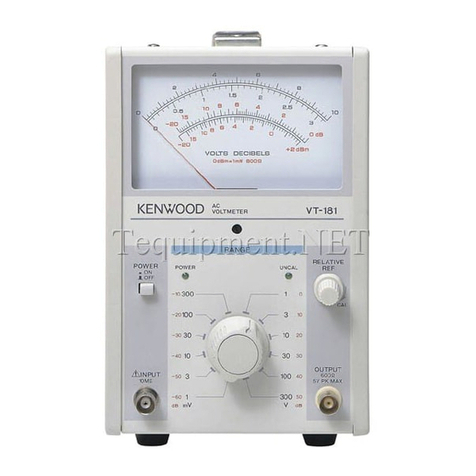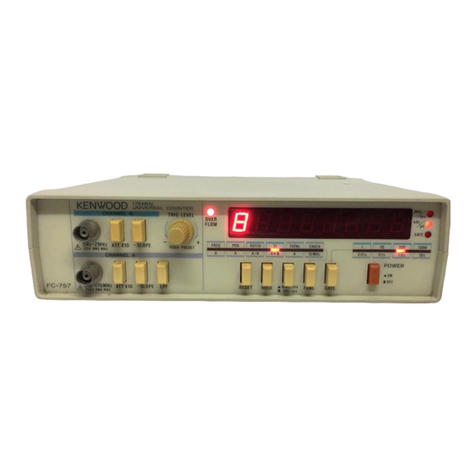
FEATURES
The
digital
memoryscopeMS-1660consistsofaDC-20MHz
bandwidth,dual-traceoscilloscope
with
a
built-in
digital
memory.Thememoryfeaturesa capacityof8 bitsx 2048
wordsperchannelanda maximumwritespeedof1
JUS/
word.The
unit
providestheabilitytostoreandreproduce
sporadic,
transientandrepetitiveevents,andrearthe
storedsignalsouttoa penrecorder,
through
simpleopera-
tion.
The
contentsofthememorycanbereadoutor
written
via
GP-IB
sothatexternaldatacanbemonitoredonthe
CRT
screenbystoringthedatainthememory.
Since
an
independentsamplingclockisprovidedforeach
channel,
separatesignalscanbestored
with
separate
clocks
atthesametime,andthesamesignalscanbe
storedata lowspeedanda highspeedatthesametime.
A
singletracecanbeusedas4Kwords.
1.
Foreachtrace,a memoryspaceof2kwordsispro-
vided.
The
unit
hastwoindependentsemiconductor
memoriesof8 bitsx 2048words
each.
2.
Dualchannel
Inputconsistsoftwoeventsata time,eachallotted
an
independentmemory
space.
Maximumwritespeed
is
1 jus/word.
3.
Dualclock
Two
completelyindependentsamplingclocksarepro-
videdtoallowsimultaneousstorageoftwo
totally
unrelatedsignals.Also,thesamesignalcanbestored
atlowspeedandhighspeed(equivalentofpartial
magnification)atthesametime.
4.
Minusdelayfunction
The
unit
iscapableofstoringthesignalsproduced
beforea triggerpulse,whicharenotobservableon
oscilloscopes.
The
dataafterthedelayset
point
canbeobservedon
theotherchannel,bymagnificationorcontraction.
The
delayset
point
iscontinuouslyvariable
with
cursor
indication.
5.
Hardcopy
The
penrecorderprovidedcanbeusedtoproducethe
hardcopyofthedisplayedwaveform
from
memory.
Inaddition,penfreerunfunctionisprovidedforauto-
matic
repetition
ofsignalstorageandcorresponding
hardcopyreproduction.
6.
Twostoragemodesareselectable.Therefreshmode
initiates
writing
with
a triggersignal.Inthepretrigger
mode,theterminationof
writing
iscontrolled
with
a
triggersignal,ineithermode,thewaveform
following
thecursor
point
canbeviewedinmagnifiedorcontract-
ed
form
intheotherchannel.
7.
Free
runfunctionforautomatic
repetition
ofread/write
operations
Once
written,thesignalsareheldina readstateforup
to20sec,thenentera writablestateinwhichthe
signals
waitfora triggersignal.
This
cycleisrepeated
automatically.
8.
Memorybackupfunction
Signals
storedremainunchangedinthememoryeven
after
turning
poweroff.
Thus
waveformsmaybe
ana-
lyzed
atanytimeonlater
days.
9.
Withthe
GP-IB
interface,thedata
within
inmemorycan
besentout,andexternaldatacanbe
written
inthe
memoryfordisplayonthe
screen.
10.
Linesynchronizationfacilitatestheobservationand
storageofthesignalsthataretriggered
with
theline
frequency.
11.
BysettingthemodetoX-Y,the
unit
changestoanX-Y
oscilloscope
with
a
one-button
operation.
12.
A rectangular,largesizedCRT
with
widerdisplay
area
providesfull-screensignalobservation.
13.
Thevertical
axis
providesa highsensitivityof1 mV/div,
plusa widebandrange
from
5mV/divtoa desiredset-
ting.
14.
The
unit
iscapableofhigh-speedsweepof20ns/div.
15.
A 150mmrectangularCRT
with
internalgraticule
(domedmeshtype,post-acceleration
with
6kVacceler-
ationvoltage)provides
easy
waveformobservation
without
parallax.
16.
The0,10,90,and100%marksonthescreenprovides
easy
measurementofrisetime.
17.
Theangleofhorizontaltracecanbeeasilycorrected
with
trace
rotation
controlsonthe
front
panel.
18.
The
scale
illuminationfacilitatesmeasurementina
darkplace,andalsoenablesphotographicrecording
oftheon-screenwaveform.
19.
Withtheautomaticfreerunfunction,thetracecanbe
checked
whilenosignalisfed.
20.
CH1
OUTPUT
terminalsareprovidedto
monitor
the
input
signalsontheCH1.
3









































